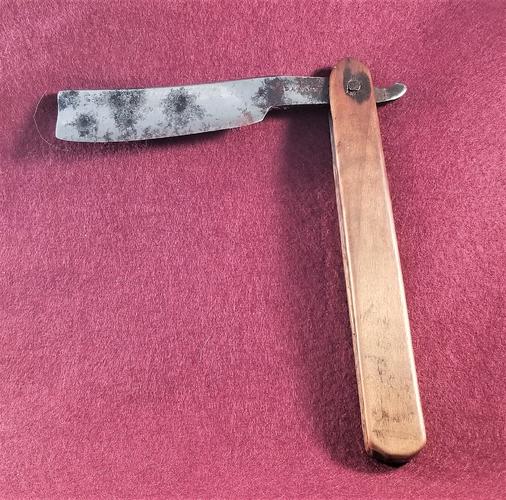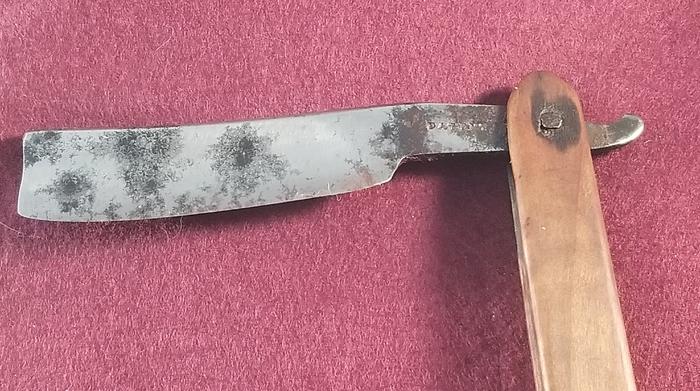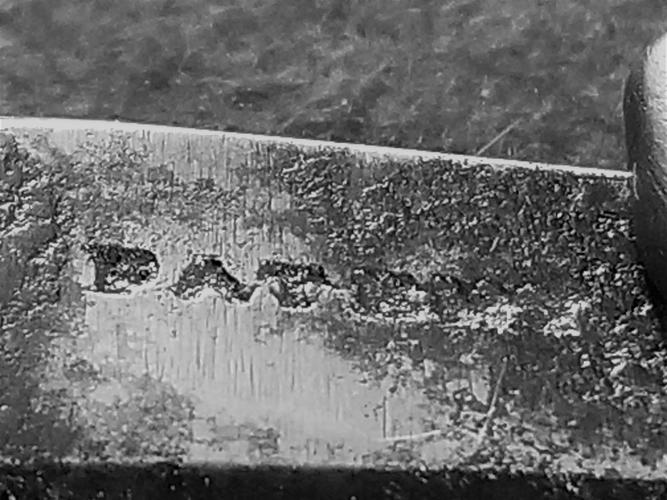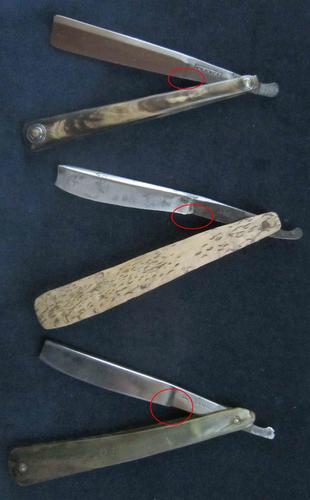Results 1 to 6 of 6
 13Likes
13Likes
Thread: The "Patent" razor .......
-
03-04-2022, 02:09 PM #1Hones & Honing




- Join Date
- May 2005
- Location
- Saint Paul, Minnesota, United States
- Posts
- 8,023
- Blog Entries
- 1
Thanked: 2209 The "Patent" razor .......
The "Patent" razor .......
Good morning!,

Todays razor is stamped "Patent" ( I think, )
)
The scales are handmade, one-piece, very thick, almost 1/4", and the nail as a pivot pin is probably not factory stuff.
The blade had a lot more black stuff on it yesterday before I did some quick work on it.
The spine is rounded.
Does anyone have an idea as to the date range?
1750-1800
1800-1850
1850-1900
Thanks guys,


 Randolph Tuttle, a SRP Mentor for residents of Minnesota & western Wisconsin
Randolph Tuttle, a SRP Mentor for residents of Minnesota & western Wisconsin
-
03-04-2022, 02:47 PM #2Senior Member




- Join Date
- Feb 2013
- Location
- Haida Gwaii, British Columbia, Canada
- Posts
- 14,454
Thanked: 4830
Just by shape I would guess 18oo’s second quarter. 1825-1850
It's not what you know, it's who you take fishing!
-
03-04-2022, 03:08 PM #3Hones & Honing




- Join Date
- May 2005
- Location
- Saint Paul, Minnesota, United States
- Posts
- 8,023
- Blog Entries
- 1
Thanked: 2209
This razor has a rounded spine.
No dip at the toe.
Single stamp on the tang.
No shoulder.
Fat, wide, tang.
Heavy weight to it.
The spine is rounded.Last edited by randydance062449; 03-04-2022 at 03:24 PM.
Randolph Tuttle, a SRP Mentor for residents of Minnesota & western Wisconsin
-
03-04-2022, 04:51 PM #4

I am with rez on that one. 1820-1850 should be the right period.
When we speak of "shoulders" on real old razors - it is something different than what we think of a shoulder on a razor today.
So we are talking about the transition between the bottom side of the tang and the blade edge. At razors prior to 1800 there was no "heel" between tang and edge it was a straight line. You can see that clearly in the following picture on the Brittain - France razor at the top.

According to Lummus around 1800 a small heel = "shoulder" appears to prevent that your thumb glides from the tang on the edge while shaving. On the picture you can see a very small shoulder at the Greaves in the middle and the Pitchford beneath. So these razors were made shortly after 1800. The more pronounced the shoulder is, the later in the early 19th century the razor was produced.
We need to be careful sometimes, because some of the pre-1800 razors which had no shoulder originally have been reground later on the bottom of the tang to specificly form a shoulder for a safer useage of the razor.
So your Patent razor clearly has a shoulder and it doesn't seem to be that large reground on the tang.
Regards Peter
-
The Following 2 Users Say Thank You to hatzicho For This Useful Post:
randydance062449 (03-04-2022), rolodave (03-04-2022)
-
03-04-2022, 07:09 PM #5Hones & Honing




- Join Date
- May 2005
- Location
- Saint Paul, Minnesota, United States
- Posts
- 8,023
- Blog Entries
- 1
Thanked: 2209
Thanks a bunch, now I understand the term "shoulder" as applied to old razors.
I am learning.
I just managed to catch a better light and the transition from the blade to the tang is not smooth. There is a grind between them, approx where the tang meets the top part of the heel/shoulder.Last edited by randydance062449; 03-04-2022 at 07:18 PM.
Randolph Tuttle, a SRP Mentor for residents of Minnesota & western Wisconsin
-
03-04-2022, 07:20 PM #6Hones & Honing




- Join Date
- May 2005
- Location
- Saint Paul, Minnesota, United States
- Posts
- 8,023
- Blog Entries
- 1
Thanked: 2209
Tomorrow I will post my only remaining "oldie" where the tang stamp is iffy.
The rest of the oldies are clearly stamped (thankfully). Randolph Tuttle, a SRP Mentor for residents of Minnesota & western Wisconsin
Randolph Tuttle, a SRP Mentor for residents of Minnesota & western Wisconsin


 LinkBack URL
LinkBack URL About LinkBacks
About LinkBacks






 Reply With Quote
Reply With Quote
